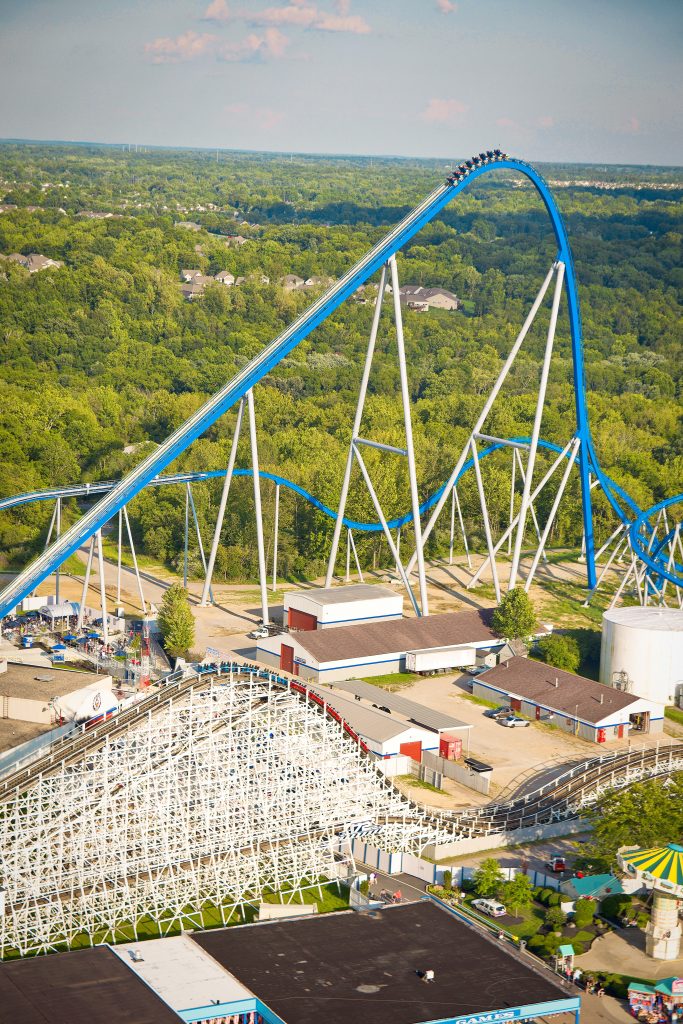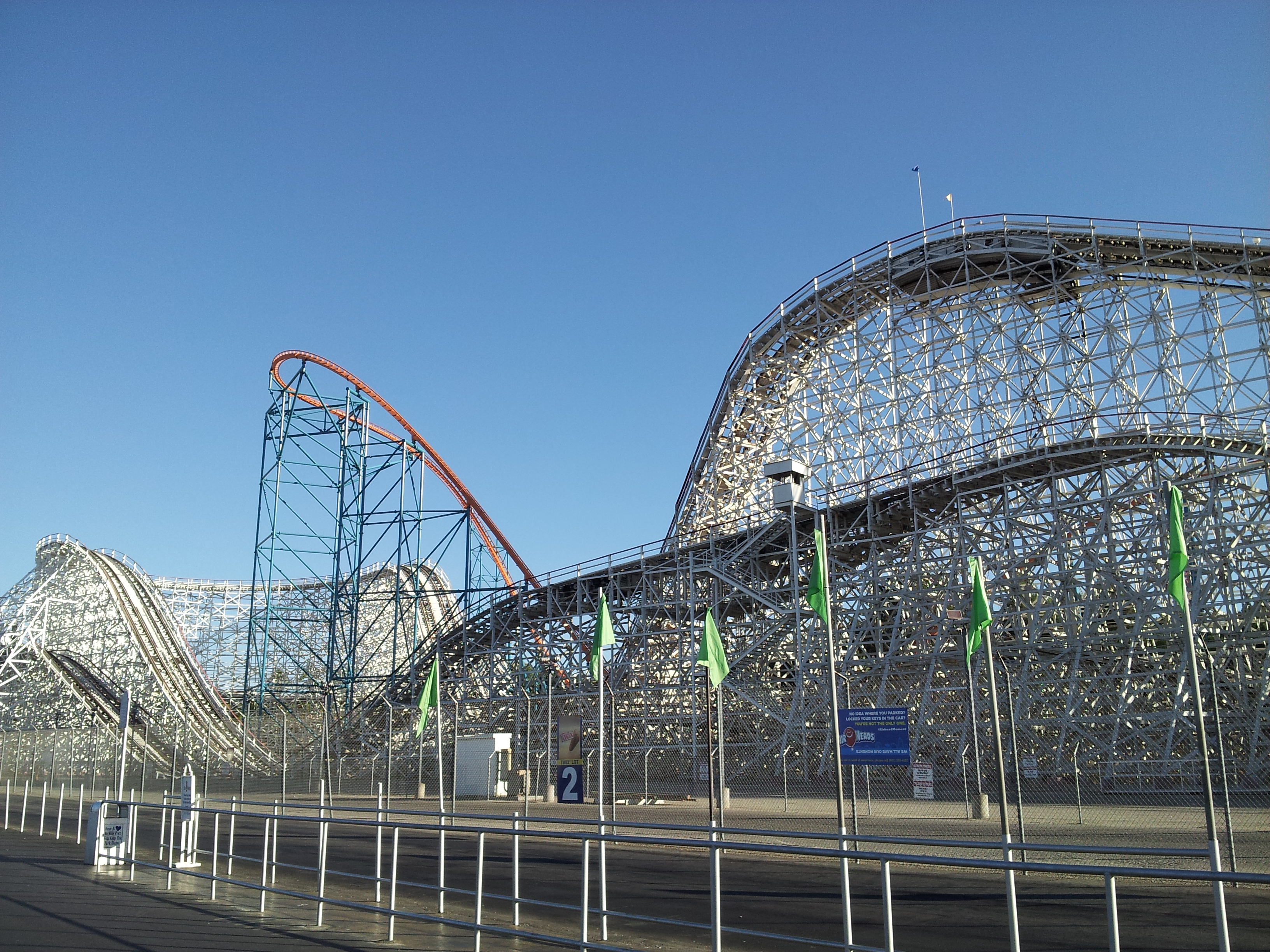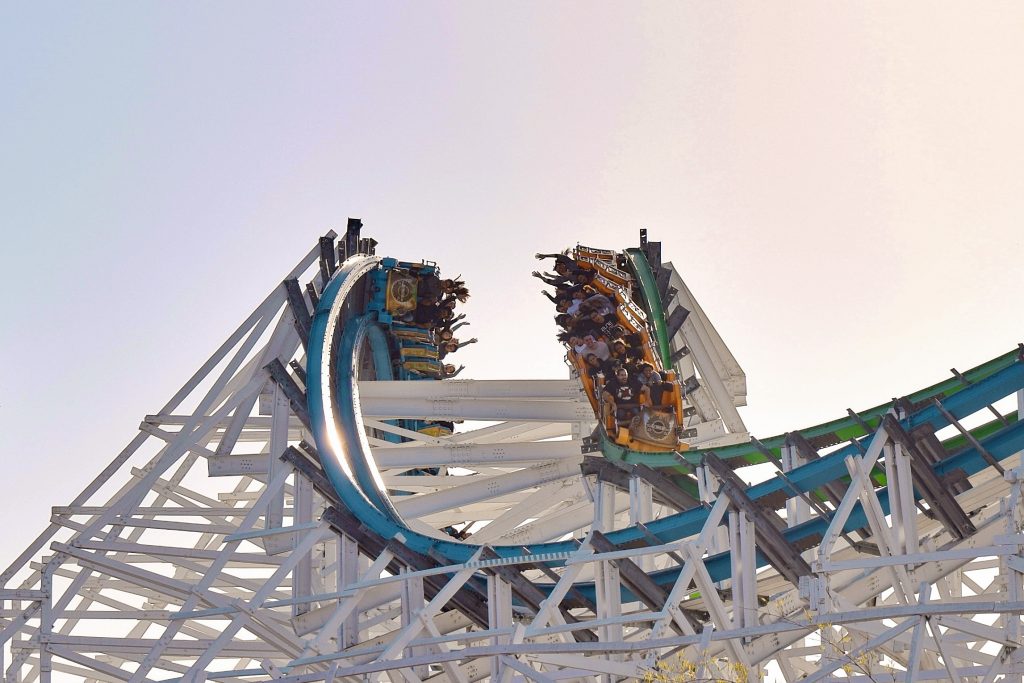When a park sets out to build the biggest, fastest, and baddest coaster around the problem always arises that its records and stature will eventually be surpassed. For Magic Mountain’s Colossus this was not a problem for much of its life. From its construction in 1978 until the construction of Viper in 1990 it was the tallest full circuit coaster in all of California. After Viper Colossus reigned as the king of the California wooden coasters until it’s RMC conversion in 2014, passing the crown to the nearby GhostRider.
– In the past, many of our images have been posted, featured, and shared on forums, social media platforms and websites around the web. We work hard to provide the coverage that we do, and we encourage our audience to share our content and use our images, BUT ONLY IF proper credit is given to thecoasterkings.com. Thank you! –
This article aligns with a special podcast mini-episode! Click the logo below to listen to the podcast!

It’s been said many times that in 1972 Kings Island’s Racer initiated a second golden age of roller coasters. It wasn’t the first large-scale thrill coaster built following World War Two but it was the one that made them essential for regional theme parks across America. Taft Broadcasting/Kings Entertainment followed up this success by opening Kings Dominion with Rebel Yell in 1975 and adding Thunder Road to Carowinds quickly after acquiring the park in 1976. Other parks took notice and Six Flags added their own series of large scale Philadelphia Toboggan Company(PTC) woodies: Great American Scream Machine at Six Flags over Georgia in 1973 and Screamin’ Eagle at Six Flags St Louis in 1976. Unfortunately after Screamin’ Eagle’s construction PTC’s president John C. Allen retired, bringing an end to this storied company’s time as a coaster manufacturer.

The demand for large scale wooden coasters remained strong and parks simply turned to other manufacturers. Cedar Point moved forward with their plans for a large scale racing coaster by hiring Arrow to build 1978’s Gemini as a hybrid coaster, Six Flags turned to former PTC designer William Cobb to create 1979’s racing Rolling Thunder for Great Adventure and 1980’s Judge Roy Scream for Six Flags over Texas, and Marriott turned to Swiss manufacturer Intamin to bring 1981’s American Eagle into reality. During this time an independent park in Valencia, California was also looking to make a splash in this increasingly competitive thrill market.

Magic Mountain chose to go with a longtime competitor to PTC, National Amusement Devices(NAD). NAD is said to be responsible for the construction of over 400 roller coasters throughout the first half of the 20th century. Today they are best remembered for the massive racing coaster, Montaña Rusa, built in 1964 at Mexico’s La Feria Chapultepec Magico. By the time Colossus was being designed NAD had been purchased and was renamed International Amusement Devices(IAD). Opening in 1978 to much fanfare, Colossus immediately became the king of the west coast. Although the 130 ft tall Loch Ness Monster took the record of tallest coaster a few weeks earlier Colossus was still marketed as the tallest(125 ft) and fastest(62 mph) coaster in the world. This claim was also made by Cedar Point for Gemini and one could say this, combined with Revolution and Corkscrew opening weeks apart in 1976, laid the groundwork for the coaster war between these two parks. Regardless of the validity of these record claims Colossus was an undisputed beast. Its intimidating structure of whitewashed wood greeted guests as they drove into Magic Mountain’s parking lot creating a visual as iconic as Revolution‘s loop over the park’s entrance plaza.

Even in it’s opening year Colossus had many of the same problems as its Mexican sister. The ride proved rough and inconsistent with excessive g-forces causing issues. After its first season the ride was modified considerably. The track was re-profiled and the original IAD trains were replaced by PTC trains. The headaches and massive cost of Colossus contributed to Newhall Land and Farming Company choosing to sell the park to Six Flags in 1979. Colossus would continue to be modified, notably receiving Morgan trains in 1987 and removing its famous double down in 1991. Although it remained one of the park’s signature coasters its reputation and ridership began to dwindle through the years. It’s location in a dead end of the park didn’t help ridership, even after the construction of Scream in 2003. When Rocky Mountain Construction began working their magic on overlooked wooden coasters Colossus became a top candidate for the budget conscious Six Flags.

The 2015 conversion of Colossus marked the end for an important California landmark. The merits of Twisted Colossus can be debated but it certainly is a different coaster than the one it replaced. Colossus was an important piece of history, a product of a time where the resurgence of wooden coasters excited the public imagination. With it’s closure California lost its entry in the first round of the coaster wars.
Did you ever get a chance to ride the original Colossus? Do you think it deserved the poor reputation it had in its later years? Next week we’ll be staying in Magic Mountain to look at a wooden coaster that is remembered far less fondly. In the next installment of “Lost Coasters of California” we’ll explore the notorious Dinn creation, Psyclone.



This is pretty false. Collosus and it’s so called Dwindling” ridership is not accurate. Sure it may not have attracted the amount of guests it did in the 80s. But just like any other roller coaster in the world, that’s what happens as they age… However I would bet money, since I don’t actually have the statistics in front of me, and the fact that I was at the park over the last 30 years hundreds and hundreds of times, that Colossus itself probably had a much better ridership at its age than any other coaster in the world at that age just about. This article making it sound like it was an abandoned attraction is 100% fabricated. The only time Colossus was a walk-on ride was when the park was dead and every other coaster was a walk-on ride. Otherwise Colossus head just about as long as a line is anything else in the park. The only thing is the ridership on that ride was much higher than anything else, so the lines moved much quicker. So in actuality, with it having almost equal lines to most of the other coasters in the park, and it having a much higher capacity, it actually probably had a better ridership than just about anything else.
I did not mean to imply that the ride was abandoned. I apologize for that impression. It certainly was a beloved attraction, but it’s ridership was not that of a signature attraction. The article is more about its fall as a signature attraction. Older rides can maintain their status in a park even as newer attractions are built(ie. The Beast or Loch Ness Monster). Towards the end I would argue that the even older Revolution continued to attract longer lines. While built with a high capacity Colossus rarely ran with both sides in its later years so its capacity was pretty comparable to the park’s other coasters. -Ian
My 1st ride on Magic Mountain’s Colossus was in 1978 right after graduation from Marine Corps Bootcamp. My mount would water looking at pics of it in the News Papers during Bootcamp freetime Sundays. After 13 weeks of intense Bootcamp, the toughest thing I’ve ever done in my adult life. I could only hande a total of 3 rides on Colossus. The ride experience was Absolutely Awful. Yes, a Rollercoaster is meant to be exciting and thrilling. Not Painful. Excessive amounts of negative g’s, the NAD Trains and the tragic death of the young Woman weren’t the makings of a Great Rollercoaster. Not to mention being down for more than 50% of the time in it’s opening year. After the purchase of Six Flags and Colossus undergoing the major reprofiling and retiring the NAD Trains with the PTC Trains, Colossus Became a World Class Wooden Rollercoaster. It had Great floater airtime without the pain. A Great Airtime Machine. As for the decline of Colossus, I blame Magic Mountain for that. There’s Classic Wooden Rollercoasters out there much older than Colossus was, still in operation. Ie, Jack Rabbit at Kennywood, Blue Streak at Cedar Point. If Colossus was well maintained after the reprofiling it received in 1979, it would still be in operation today. The PTC Trains may have been switched out with the ratcheting Lap Bars PTC Trains, but I wouldn’t have cared one single bit. Just as long The Classic Colossus Rollercoaster I sorely miss was still in operation.
When Colossus first opened, I was there. Ride operators wore helmets, boots, and looked intimidating as hell. I remember they used to walk along side the cars and look down at the riders in the station getting situated. They would simply say things and point like, “The hat is gone, the bear is gone, the glasses are gone……”…they were referring to what was going to happen to those belongings if you didn’t batten them down immediately. Quite a head-trip before the ride even began. It was epic.
While I love Twisted Colossus, I really miss the original. It was my all-time favorite wooden coaster, and I really wish it could be brought back sometimes.